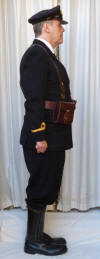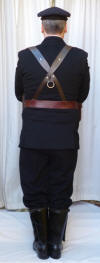



B30
1901/1912 AUTOMATIC SETS
Also known as the 1912 pattern the Webley automatic sets were only a holster and an ammunition pouch developed to be worn on the 1901 pattern webbing.
The Webley .455 automatic Mk1N (Naval) was the first automatic pistol to enter British military service being accepted for use in 1912, quantity production began in that year with the first issue to Naval units in 1913, it was closely followed by a mark two with adjustable sights !!!! for both the Royal Flying Corps and the Royal Artillery.
The standard set first seen just prior to the outbreak of WW1 is displayed below, rank is Sub Lieutenant.
The private purchase 01/08 holster is worn in this series.
In this sequence the privately bought 01/08 holster is on the 1908 webbing, a very rarely seen combination.
Around 7,000 Webley automatics were issued from 1913 onwards with 4,000 being in service by the outbreak of war, the unfortunate looks of this weapon rather reminiscent of a child's ray gun tend to cloud the fact that was a devastating weapon with fearsome stopping power, the magazine clip of seven big rounds was housed inside the handle so the empty clip could be dropped out and replaced very quickly giving automatics much faster reload times than revolvers, this gun was reduced to second line status in the mid 1930s but its ammunition was still being produced in 1939 and still being issued in 1940, all surviving Webley Autos were finally deleted in 1947.
Another fine automatic to see Royal Naval service from late 1915 was the American made Colt M1911 which was modified to accept the .455 Webley Auto bullets, recent American research has revealed that 12,500 were supplied with a second batch of 1,500 following in 1919, all of these modern Colts were withdrawn from R.N. service in 1921 to be re-issued to the RAF just prior to WW2.
The Webley auto holster was first issued in 1913 and a level top edge to the flap indicates that it was made for an automatic pistol, revolver holsters by this date were usually angled upwards, below is the standard issue type with a tiny J & A Hillman Limited makers stamp showing a 1913 date of manufacture, this type of holster was right handed so neither a sword nor a cutlass was worn on this set.
This second example was made in 1914 by Hobdon & Sons of London and has a non standard 08 pattern buckle added on top as an original fitting yet retains the normal 01 belt loops so can be worn on either pattern, slightly browner than issued 1901 webbing it has RMA and a serial number pen marked inside, RMA stands for Royal Marine Artillery which was formed in 1804 and amalgamated in 1923, in 1914 there were two Royal Marine Artillery brigades serving on the western front, one was an anti-aircraft brigade and the second was a heavy howitzer brigade.
The 49 round ammunition pouch for the auto was taller and narrower than the 01 revolver pouch and deleted the external loops, instead four brass clips were fitted inside to hold two loaded 7 round magazines horizontally above with seven 7 round paper packs stored vertically below, this awkward arrangement does not seem to have been popular as many had the brass clips removed.
The standard 1901 pattern belt and braces were worn with this set.
This type of holster is something of an enigma, identical in size to the auto holsters above it has a tiny J & A Hillman makers stamp and is dated 1913 with an "N" on its closure strap, initially I believed this variant to have been made for the RN Colts but the dates do not tally then one of these turned up in an auction matched to Webley Fosbery which was a perfect fit, this was the fifth example of this holster that I have seen and not one of them retained their original 01 pattern fittings, two had been converted to 08 pattern two had new leather shoulder straps added and one lacked any rear fittings at all.
The Webley .455 Fosbery was a semi-automatic revolver first seen in 1901, its lower half was on a slide arrangement and like a machine gun it utilized its recoil energy to re-cock the weapon to produce a smooth trigger action to improve steady aiming but was then reloaded the normal revolver way, stowed half cocked it had a safety catch fitted which was unusual for the time, far too complicated and frail for the rigors of World War One this weapon failed badly and was universally discarded, production ceased in 1915 after less than 7,000 had been made, if this holster was designed for this gun then it must have been a pre-war private purchase item as the Fosbery was never issued to the Royal Navy, officers of the land based Royal Naval Division may have trialed privately obtained Fosberys hence the conversions to 08 pattern webbing, this holster may have been reused for the Naval Colt automatics also carried in the Webley auto holsters seen above.
The Chief Gunlayer below wears the single breasted jacket first seen in 1891 which became the standard WW1 Petty and Chief Petty Officers blues uniform, the same cap badge was used by both ranks but C.P.O.s wore collar badges and P.O.s had arm badges, relegated to a working jacket by 1935 it disappeared entirely in 1956, this jacket was also worn by non seaman ratings with a red cloth cap badge that is still regularly mistaken for a P.O.s cap badge, to add to our confusion just prior to the outbreak of WW1 engine room artificers wore the same P.O. uniform but without the crossed anchor arm badges, Royal Naval Air Service ratings wore a double breasted black buttoned blues uniform, webbing sets below are for the Fosbery on 1901 pattern and 1908 pattern.
The Great War CPO/PO cap badge is on the left, the Royal Naval Air Service cap badge on the right is a very late version the dashing anchor types being previously worn.
HOME